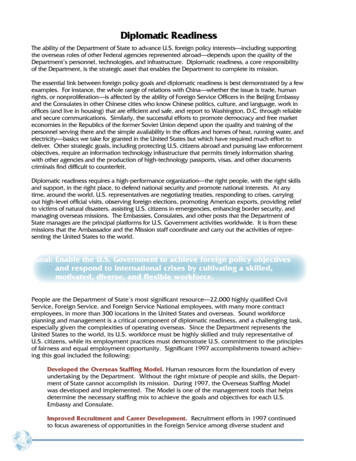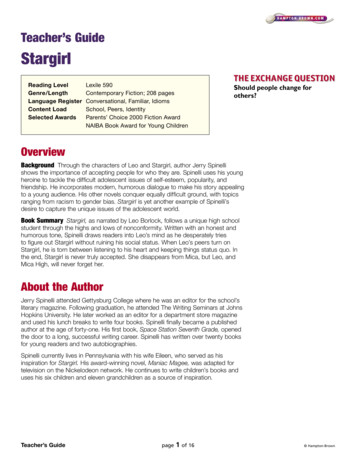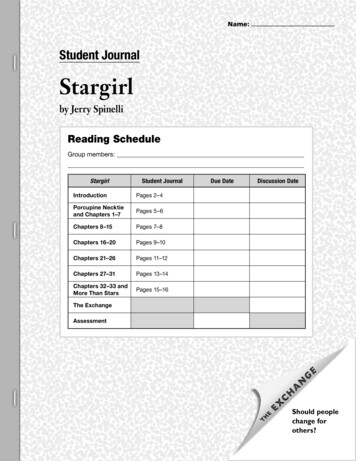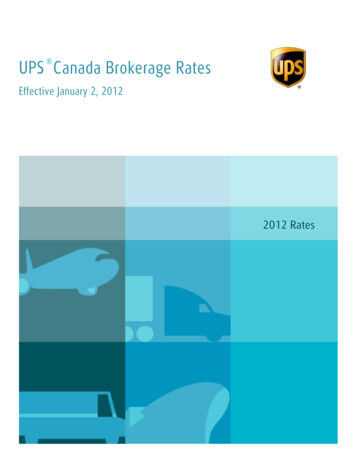
Transcription
Diplomatic ReadinessThe ability of the Department of State to advance U.S. foreign policy interests—including supportingthe overseas roles of other Federal agencies represented abroad—depends upon the quality of theDepartment’s personnel, technologies, and infrastructure. Diplomatic readiness, a core responsibilityof the Department, is the strategic asset that enables the Department to complete its mission.The essential link between foreign policy goals and diplomatic readiness is best demonstrated by a fewexamples. For instance, the whole range of relations with China—whether the issue is trade, humanrights, or nonproliferation—is affected by the ability of Foreign Service Officers in the Beijing Embassyand the Consulates in other Chinese cities who know Chinese politics, culture, and language, work inoffices (and live in housing) that are efficient and safe, and report to Washington, D.C. through reliableand secure communications. Similarly, the successful efforts to promote democracy and free marketeconomies in the Republics of the former Soviet Union depend upon the quality and training of thepersonnel serving there and the simple availability in the offices and homes of heat, running water, andelectricity—basics we take for granted in the United States but which have required much effort todeliver. Other strategic goals, including protecting U.S. citizens abroad and pursuing law enforcementobjectives, require an information technology infrastructure that permits timely information sharingwith other agencies and the production of high-technology passports, visas, and other documentscriminals find difficult to counterfeit.Diplomatic readiness requires a high-performance organization—the right people, with the right skillsand support, in the right place, to defend national security and promote national interests. At anytime, around the world, U.S. representatives are negotiating treaties, responding to crises, carryingout high-level official visits, observing foreign elections, promoting American exports, providing reliefto victims of natural disasters, assisting U.S. citizens in emergencies, enhancing border security, andmanaging overseas missions. The Embassies, Consulates, and other posts that the Department ofState manages are the principal platforms for U.S. Government activities worldwide. It is from thesemissions that the Ambassador and the Mission staff coordinate and carry out the activities of representing the United States to the world.Goal: Enable the U.S. Government to achieve foreign policy objectivesand respond to international crises by cultivating a skilled,motivated, diverse, and flexible workforce.People are the Department of State’s most significant resource—22,000 highly qualified CivilService, Foreign Service, and Foreign Service National employees, with many more contractemployees, in more than 300 locations in the United States and overseas. Sound workforceplanning and management is a critical component of diplomatic readiness, and a challenging task,especially given the complexities of operating overseas. Since the Department represents theUnited States to the world, its U.S. workforce must be highly skilled and truly representative ofU.S. citizens, while its employment practices must demonstrate U.S. commitment to the principlesof fairness and equal employment opportunity. Significant 1997 accomplishments toward achieving this goal included the following:Developed the Overseas Staffing Model. Human resources form the foundation of everyundertaking by the Department. Without the right mixture of people and skills, the Department of State cannot accomplish its mission. During 1997, the Overseas Staffing Modelwas developed and implemented. The Model is one of the management tools that helpsdetermine the necessary staffing mix to achieve the goals and objectives for each U.S.Embassy and Consulate.Improved Recruitment and Career Development. Recruitment efforts in 1997 continuedto focus awareness of opportunities in the Foreign Service among diverse student and16
Diplomatic Readinessprofessional groups, which yielded higher percentages of minority group applicantsapplying and qualifying for Foreign Service positions. In addition, a new program topermit Civil Service personnel, who are predominantly employed in Washington, D.C.,offices, to apply for conversion to the Foreign Service and/or assignment to Foreign Servicepositions overseas that are difficult to fill has been implemented.Expanded Training at the Foreign Service Institute. Once the Department has recruitedthe right talent, it must ensure that the personnel system provides incentives for excellenceand the opportunity for each employee to fully use his or her abilities. The ForeignService Institute (FSI), located at the National Foreign Affairs Training Center (NFATC) inArlington, Virginia, equips employees with first-rate language and area expertise; honestheir diplomatic tradecraft skills, notably in reporting, advocacy, negotiation, and consularwork; and strengthens skills needed to manage people, information, and other resources.Following are some key accomplishments realized by FSI in 1997: Expanded leadership and management training in the Senior Seminar, which is a 9-month curriculum for executives in both the Civil Service and Foreign Service who serve in keyleadership positions both in Washington, D.C., and overseas.Increased training in information technology to support the Department’s informationsystem modernization efforts.Expanded diversity training throughout the Department in 47 sessions, includinglocations overseas in London, Brussels, Moscow, and Mexico City.Improved delivery of training services through alternative pricing mechanisms andnew delivery methods, such as distance learning.Updated training in consular functions with new computer platforms that enabletraining on the most recent consular information systems programs operating overseas.Goal: Strengthen the ability of the United States to achieve its international affairs goals and respond to crises through effective andefficient information resources management and information systems.The collection, analysis, and communication of information concerning international issues anddevelopments of importance to the U.S. Government are essential to achieving foreign policygoals. Given the vast quantities of information available today, there is a premium on valueadded and timely information. Secure and reliable information technology, along with accurateand efficient information networks, are essential tools for the policy process and operations athome and abroad. They are equally critical for the effective conduct of foreign relations and forcommunications with the rest of the government and the public. During 1997, the Department ofState focused on two major areas:Continued Modernization of Information Management. The Department’s strategicinformation resource management challenge is to align information management prioritiesin such a way as to strike the appropriate balance between classified and unclassified information needs. Currently, resources are spread across various large-scale networks, including a closed classified record traffic network and its associated classified electronic mailsystems, and an open, unclassified network. Modernizing even a single, large-scale networkis challenging, given today’s expensive and constantly changing information technology. Inorder to do well in deploying and supporting an open, unclassified network linked to theInternet, the Department is modernizing its computer and communications networks.Addressed Year 2000 Issue. As we proceed along the track of installing new, open,unclassified systems around the world, it is essential that we also ensure that existing systems are year 2000 compliant. During 1997, the Department continued to analyze its information systems applications and renovate systems to meet the requirements of the newmillennium including OMB’s March 1999 mission critical application compliance deadline.17
Diplomatic ReadinessGoal: Establish and maintain infrastructure and operating capacities thatenable employees to pursue policy objectives and respond to crises.The Department of State operates and maintains a network of diplomatic and support facilities in morethan 300 locations worldwide, ranging from highly developed countries with advanced infrastructureto underdeveloped or crisis-bound nations without reliable communications, transportation, or banking systems. The Department must respond to a vast array of support needs at overseas posts,ensuring that representatives from all Federal agencies and their families can live and conduct businesssafely and efficiently, with due regard for morale, even in unhealthy or dangerous locations.Resource Management Improvement - ICASSPerhaps the single most significant improvement in resource management has been to the administrative support infrastructure worldwide with the continued development and implementation of theInternational Cooperative Administrative Support Services (ICASS) system. It is a revolutionary changein the way the Department manages the delivery of shared administrative support services and distributes the associated costs to U.S. Government agencies located at diplomatic missions abroad. Itincorporates many of the important pillars of entrepreneurial government supported by the VicePresident’s NPR. The new ICASS system is more than just a revised cost distribution mechanism thatallocates to each agency the full costs of its presence overseas. ICASS is a paradigm shift in the waythe Department of State and other Federal agencies manage the administrative platform that supportstheir overseas programs and activities. The primary objective is quality services at the lowest cost.There are five major principles of the ICASS system:Local Empowerment. Each Embassy forms an ICASS Council, made up of senior managersrepresenting each agency at the post. Similar to a corporate board of directors, the Council isresponsible for the overall management of shared administrative support activities, includingusing resources cost effectively, choosing service providers, establishing customer servicestandards, and setting priorities within the administrative support delivery system.Equity. Under ICASS, agencies pay their fair share of post administrative costs based onusage. ICASS embodies the concept that all agencies should pay the true costs of theirpresence overseas.Transparency. All costs are clearly shown by agency for all post-related and non-post-relatedservices, using an agreed-upon method. The ICASS budget and management informationsystem permits every post and agency to review and influence the shared administrative costs,by service and by agency.Competitive Selection of Service Providers. Under ICASS, diplomatic posts have the flexibilityto select service providers. Through their Councils, posts have the option, where practical, oflooking at other providers (governmental or commercial) to obtain administrative support,consulting, and professional services in lieu of or in addition to those provided by the Department.Customer Service Standards and Accountability. The local Councils establish standards foradministrative services and evaluate the performance of the service providers in meeting them.The agencies at post, who are the customers, hold the service providers accountable for theirperformance and, through the Council, seek ways to improve services and reduce costs.ICASS is being implemented in accordance with a four-phase plan, with the ultimate objectivebeing the full implementation of the system worldwide in 1998. The first and second phases of theimplementation plan were completed in 1996. They consisted of the initial testing of ICASSconcepts at four pilot posts in Rome, Riga, Warsaw, and San Salvador; evaluating the results; andmaking necessary changes to the system.18
Diplomatic ReadinessOn October 1, 1996, the third phase of the implementation plan was initiated—a prototypeversion of ICASS was installed worldwide to test and further refine policies, procedures, andsystems. Although ICASS has been established at 162 diplomatic missions abroad, during 1997,participating agencies continued to reimburse the Department of State using the cost-distributionmethodology of the old Foreign Affairs Administrative Support System. However, ICASS budgetdata from the test year formed the basis for a budget amendment request that transferred, for1998, approximately 110 million from the Department to other participating agencies to covertheir increased share under ICASS.The last and final phase of ICASS, full implementation, will be accomplished in 1998 with agenciespaying a more equitable share of the administrative support costs associated with their presenceabroad. In return for increased costs, other agencies have a greater voice in the management ofadministrative resources at post, with a focus, as customers, on improved services in a competitive environment. This will be a significant achievement for the Department and all Federal agencies with operations overseas.Other Management ImprovementsFollowing are other notable management improvements realized in 1997:Formalized Strategic Planning. Significant and lasting progress was made during 1997toward the full implementation of the Government Performance and Results Act (GPRA) withthe development of the Department’s first Strategic Plan and the International Affairs Strategic Plan. By setting the long-range direction of the Department in defining its mission andthat of other foreign affairs agencies/components and key goals and objectives in the Strategic Plan, all employees and associates in other Federal agencies as well as our counterpartsin the worldwide community of diplomacy, know where the interests of the United States liein the field of foreign affairs. The Strategic Plan was the result of a vigorous process involvingemployees at all levels of the Department and other Federal foreign affairs agencies. Itpresents appropriate goals based on a thorough analysis of the political, economic, andenvironmental status of the world.Improved Logistics Management. During 1997, the Department continued developmentand implementation of a new logistics management organization that will reengineer andstreamline logistics functions encompassing procurement, delivery and storage of goods,and provision of services for all Department locations worldwide.Sharpened Focus of Real Estate Asset Management. The Department strives to maximizethe economic use of its U.S. Government-owned real property overseas. Because needs andfunctions of diplomatic posts change, the Department reviews its real property inventory toidentify those properties that may be underutilized, functionally inadequate, expensive tomaintain, or otherwise excess to its needs. The focus is to identify and dispose of real estateand use the proceeds of sale to acquire, via purchase or construction, lower cost replacements, high-priority core properties, and other financially attractive properties worldwide.Ownership serves as protection from the risk of recurrent make-ready and upgrade costsand against rent escalation. During 1997, the Department sold nearly 102 million of real property. The amount realized from the sale of real property is not available for obligation until credited to theSecurity and Maintenance of U.S. Missions appropriation. In 1997, 96.7 million inproceeds were credited to this appropriation.The Department purchased 85 properties overseas for 34.6 million. In addition topurchase and lease methods of providing office space and housing, the Departmentconstructs new facilities and extends the useful life of existing facilities through maintenance and rehabilitation work.19
Diplomatic Readiness In 1997, the Department completed several new construction and facility rehabilita-tions, exceeding 10 million—the construction of a new Chancery, Ambassador’sresidence, and Marine Security Guard quarters in Singapore, a U.S. Interests Sectionrehabilitation in Havana, and a Consulate General rehabilitation in Hong Kong.Upgraded Security. The Department of State is dedicated to providing a secure workingand living environment for all employees domestically and overseas. The recent bombingsof the U.S. Embassies in Kenya and Tanzania are devastating and tragic examples of the risksthat all U.S. Missions face in carrying out the worldwide foreign af fairs program. Theseevents have resulted in the Department requesting supplemental resources from the Congress to fund emergency activities to rebuild the destroyed Embassies in Nairobi and Dar EsSalaam and to increase security in our posts worldwide. Our security program must not onlyprotect the lives and property of Department of State, American and Foreign Nationalemployees, but also Department facilities that provide support for other U.S. governmentemployees working overseas (outside of military installations).During 1997, the Department upgraded security training for local guard forces that, togetherwith Marine Security Guard detachments, protect the perimeter and access to each post.Security was enhanced at many posts in high threat areas with new metal detection devicesand closed-circuit security monitors. Also, to protect classified material or information,special intrusion detection systems were installed at 25 posts. In addition to protectingpeople, the Department must secure its information management systems. As part of theDepartment’s information technology modernization effort, new stringent security standardshave been adopted and analyses of hardware and software are being conducted to determine necessary security upgrades.Strengthened Financial and Accounting Systems. At present, the Department’s financialand accounting systems do not comply with government standards and regulations. TheDepartment has been burdened with managing six financial management systems throughout the world to support its own operations as well as those of other Federal agencies withoverseas operations. The long-term goal is to have a single integrated accounting system.In pursuit of this goal, over the past few years, the number of financial systems has beenreduced from six to three; the three overseas financial service centers were standardized ona single foreign national payroll system (three dif ferent payroll systems existed before); andthe number of disbursing offices were reduced from 18 to 3. In addition, the followingactions were taken during 1997: Developed a standardized account code structure to improve systems integrationDepartment-wide. Prepared a detailed implementation plan to upgrade the off-the-shelf accountingsystem software for the Central Financial Management System (CFMS). Conducted indepth analyses of CFMS software changes and completed programming for half of the changes, with the remainder to be completed during 1998,when the upgrade is scheduled to be installed.20
Management Discussion andAnalysis of Financial StatementsThis is the second year that the Department has prepared Department-wide consolidated financialstatements, which is an important step toward promoting improved accountability and stewardship over the public resources entrusted to the Department. Preparing these statements is part ofthe Department’s overall goal to improve financial management and to provide accurate andreliable information that is useful in assessing performance and allocating resources.Responsibility for the integrity and objectivity of the financial information presented in the financialstatements rests with Department management. The accompanying financial statements havebeen prepared in conformity with the hierarchy of accounting principles approved by the FederalAccounting Standards Advisory Board (FASAB). The financial statements should be read with therealization that the Department is an agency of the executive branch of the U.S. Government, asovereign entity. Accordingly, unfunded liabilities reported in the statements cannot be liquidated without the enactment of an appropriation, and ongoing operations are subject to enactment of appropriations.Subjecting financial statements to an independent audit enhances their reliability. Leonard G.Birnbaum and Company, independent certified public accountants, was retained by the Department’s Office of Inspector General to audit the Department’s 1997 consolidated financial statements. Its accompanying report is based on an audit conducted in accordance with generallyaccepted auditing standards, Government Auditing Standards issued by the Comptroller Generalof the United States and OMB Bulletin 93-06, Audit Requirements for Federal Financial Statements.We are pleased to report that the auditors rendered an unqualified opinion on our 1997 financialstatement, the best possible outcome of an independent audit.Comparative financial statements are presented for 1996 and 1997. The 1996 data have beenrestated to include the Bosnia Federation Fund. In 1996, the Statement of Financial Position wasaudited and received a qualified opinion. The opinion was qualified due to the inability of theauditors to obtain sufficient documentation on undelivered order balances.The breadth of scope of the Department’s financial activity is shown in the consolidating statements by major functional area, which are included as supplemental data. These areas are Administration of Foreign Affairs, the Foreign Service Retirement and Disability Fund (FSRDF), International Organizations and Conferences, International Commissions, and Other Funds. Except forFSRDF, which is part of Administration of Foreign Affairs, this classification is consistent with theBudget of the U.S. Government. FSRDF is displayed separately because it contains more than 50%of the Department’s assets.Financial Condition. The Department had total assets of 16.8 billion as of September 30,1997. Investments in U.S. Government Securities of 9 billion and Property and Equipment(net) of 4.4 billion make up nearly 80% of this amount. The investments consist entirely ofinvestments by the FSRDF and Gift Funds. Property and Equipment is primarily composed ofoverseas real property of 3.8 billion under the Security and Maintenance of U.S. MissionsFund. The Administration of Foreign Affairs and FSRDF activities contain approximately 92% ofthe Department’s total assets.Total assets increased only 0.8 billion, from the 16.0 billion in total assets as of September30, 1996. Investments increased by almost 0.6 billion due to interest earned. Intragovernmental receivables decreased slightly due to prompt billing and more aggressive collectionactions. The increase in governmental receivables of 0.2 billion was primarily due to theestablishment of accounts receivable for several real property sales for which payments havenot been received.21
Management Discussion and Analysis of Financial Statements(FSRDF)The Department had total liabilities of 13.1 billion as of September 30, 1997. Of this amount, 10.5 billion (80%) was for the FSRDF’s Pension Actuarial Liability and 1.7 billion (13%) wasfor Assessments from International Organizations. The FSRDF and International Organizationsactivities contain 93% of the Department’s liabilities. Of the Department’s total liabilities, 3.4billion (26%) was unfunded, i.e., not covered by budgetary resources. The largest portion ofthe unfunded liabilities is 1.7 billion in accumulated arrears on assessments from internationalorganizations.Since 1996, total liabilities increased by 1.3 billion. This increase was due primarily to achange in the method for reporting the actuarial liability for the FSRDF.Results of Operations. For the fiscal year ending September 30, 1997, the Department had 6.8 billion in revenues and financing sources. Appropriated Capital Used of 5.2 billionmakes up 76% of this amount. The Department realized Sales of Goods and Services of 1.2billion. Of this amount, approximately 632 million was for passport and other consular fees, 464 million of which was deposited in the U.S. Treasury as general receipts. The other 52122
Management Discussion and Analysis of Financial Statementsmillion in Sales of Goods and Services realized were primarily for reimbursable services provided to other Federal agencies through ICASS. The Department also received 675 million ininterest earned on investments, primarily in the FSRDF. Prior to interfund eliminations, theAdministration of Foreign Affairs, International Organizations, and FSRDF make up 56%, 16%,and 14%, respectively, of the total Revenues and Financing Sources.For the fiscal year ending September 30, 1997, the Department incurred 6.2 billion in expenses. Program or Operating Expenses of 5.8 billion make up 93% of this amount. Of the 5.8 billion in Program or Operating Expenses, 2.1 billion (36%) was for grants and contributions (primarily to international organizations), and 1.4 billion (25%) was for personnelcompensation. The Administration of Foreign Affairs, International Organizations, and ForeignAssistance make up 58%, 17%, and 14%, respectively, of the total expenses prior to interfundeliminations.23
Management Discussion and Analysis of Financial StatementsTotal expenses decreased in 1997 by 1.6 billion, primarily due to a one-time recognition in1996 of 1.7 billion in accumulated arrears for unfunded assessments from the United Nations,its affiliated agencies, and other international organizations. This also accounts for the decrease, from 37 to 17%, for International Organizations as a percentage of total expenses.For the fiscal year ending September 30, 1997, the Department reported an 580 millionexcess of net revenues and financing sources over total expenses. More than 60% of thisamount is due to revenues generated by FSRDF. Other activities contributing to this totalinclude sales of real property, consular fees retained by the Department, and a decrease in theunfunded liability for international organizations.Budgetary Issues. The Department’s operating budget provides the basic platform for thedelivery of the nation’s foreign policy as well as the infrastructure to support all U.S. Government civilian operations overseas. The operating budget has been essentially flat since 1993,and buying power has been eroded by 17% due to inflation. As a result, the Department hashad to cut nearly 3,000 employees, close more than 30 embassies and consulates, and deferessential modernization of infrastructure and communications. At the same time, workloadhas increased, including growing visa and passport issuance, an increasing number of crises tomanage, more difficult-to-support overseas posts, and increased security threats, such asterrorism, nuclear smuggling, and international crime.While operating within a complex environment, the Department’s infrastructure has eroded,resulting in crucial staffing and training gaps, inadequate Foreign Service National pay plans,and unmet vehicle, furniture, telephone, and information technology equipment needs. In1999, the Department faces major infrastructure investment demands for worldwide security,information technology equipment modernization, increased telecommunications capacity,and year 2000 compliance. The Department also faces challenging policy demands, includingimplementation of the Dayton Peace Accords, the Middle East Peace Process, Asian economiccrisis, trade negotiations, North Korea nonproliferation issues, environmental programs,relations with China, NATO expansion, relations with the United Nations and other international organizations, and relations with rogue states, each of which requires resource allocations.While carrying out its mission, the Department must continue to pursue the President’s plan toconsolidate the Arms Control and Disarmament Agency and the United States InformationAgency into the Department, thus better integrating arms control and public diplomacy intothe mainstream of foreign policy.The Department’s 1999 budget request of 4.9 billion includes a small (about 4.8%) increase,enough to cover overseas and domestic inflation, key program and investment initiatives, andpartial replacement of obsolete information technology. The Department’s 4.9 billion requestrepresents approximately 24% of the overall International Affairs request, which is only 1% ofthe total Federal budget. For 1998, the Department of State is requesting 1.4 billion insupplemental funding to improve overseas security, restore the Embassies in Kenya andTanzania to full capacity and cover costs already incurred resulting from the bombings (such asevacuation costs and medical expenses for care of American and local employees). Also, fundsare included to accomodate immediate security needs at other posts, upgrade physical security worldwide and construct new facilities both for the Department and other agencies.In 1997, the Department implemented two major reforms to improve the management of diplomacy. The first, a new overseas administrative arrangement—the ICASS program—more equitably allocates among all agencies with an overseas presence the costs of overseas administrativesupport. The second reform is a reengineering of the Department’s logistics system that eliminates cumbersome procedures, provides faster services, and significantly reduces the cost of thoseservices. The 1999 budget proposes funding for two significant, new projects:24
Management Discussion and Analysis of Financial Statements Construction of a new embassy building and related facilities in Beijing, where current arrangements are inadequate to conduct diplomacy with a major world power and toensure security from espionage.Construction of an embassy building in Berlin, where U.S. personnel have been in temporary facilities since their move
Service, Foreign Service, and Foreign Service National employees, with many more contract employees, in more than 300 locations in the United States and overseas. Sound workforce planning and management is a critical component of diplomatic readiness, and a challenging task, especially given the complexities of operating overseas.











